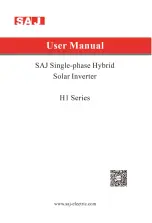
©
2010 Magnum Energy, Inc
.
DC Overcurrent Protection
For safety and to comply with electrical code regulations, you must
install a DC overcurrent protection device in the positive DC cable
line to protect your DC cables. This DC overcurrent device must be
DC rated and can be a fuse or circuit-breaker. It must be correctly
sized according to the size of DC cables being used, which means it
is required to open before the cable reaches its maximum current
carrying capability, thereby preventing a
fi
re.
See Table 1 to select
the DC overcurrent device needed based on the minimum wire size
according to your inverter model.
Electrical systems in mobile installations typically do not require
using a DC disconnect, although an overcurrent protection device is
still required. Because the DC disconnect is not required, a fuse is
usually used as the overcurrent device in these installations. These
installations also do not normally use conduit, so the fuse
must be
installed
in the ungrounded conductor (usually the positive DC cable
line)
within 18 inches of the battery – to protect the DC wiring system.
If using a fuse, we recommend using a
class-T type or equivalent. This
fuse type is rated for DC operation, can
handle the high short-circuit
currents, and
allows for momentary current surges from the inverter
without opening.
DC Grounding
The inverter/charger should always be connected to a permanent,
grounded wiring system.
The idea is to connect the metallic chassis
of the various enclosures together to have them at the same voltage
potential, which reduces the possibility for electric shock.
For the
majority of installations, the inverter chassis and the negative battery
conductor are connected to the system’s ground bond via a safety-
grounding conductor (bare wire or green insulated wire) at only one
point in the system. Per the NEC, the size for the grounding conductor
is usually based on the size of the overcurrent device used in the DC
system.
Refer to Table 1
to select the appropriate DC ground wire
based on the overcurrent device used for your inverter model.
If using this inverter in a vehicle, DO NOT connect the battery negative
(-) cable to the vehicle’s safety ground. Connect it only to the invert-
er’s negative battery terminal. If there are any non-factory installed
DC appliances on board the vehicle, DO NOT ground them at the safety
ground. Ground them only at the negative bus of the DC load center
(as applicable).
2.0 Installation
13
















































